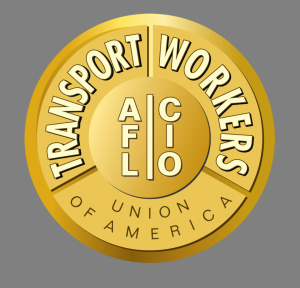Difference between revisions of "Human resources"
Rabiabonour (talk | contribs) |
|||
| (9 intermediate revisions by 4 users not shown) | |||
| Line 1: | Line 1: | ||
| + | {{template:stub}} | ||
| + | [[File:Transport workers union.png|thumbnail|right|Transport Workers Union of America Logo Source: www.nhlabornews.com]] | ||
| + | [[Category:Managing transit]] | ||
| − | |||
| + | ==Productivity== | ||
| + | Labor productivity in transportation service has declined in recent decades. Unions have grown in membership and influence and have often won workers such contract elements as the eight-hour work day. As an example, the eight-hour work day brings workers stable income and often benefits associated with full-time employment. Transit operation, however, does not lend its self well to eight-hour work shifts. Because transit demand peaks in the morning and afternoon commute times, more workers are needed during these periods than in the middle of the workday. Without part time or flexible shift workers, transit agencies are forced to staff full-time vehicle operators to their highest peak demand, losing many hours of productivity when these same workers are idle midday. | ||
| − | |||
===Strategies for increasing labor productivity=== | ===Strategies for increasing labor productivity=== | ||
| − | + | Several strategies exist for increasing labor productivity. Two of the most common strategies are [[contracting transit operations]] and [[altering labor regulations]]. | |
| − | Several strategies exist for increasing labor productivity. Two of the most common strategies are [[contracting | ||
=== When to use contracted labor === | === When to use contracted labor === | ||
| − | + | Though contracting service often leads to losses to labor, such as a decline in wages and benefits, contracting service can be beneficial to transit agencies in some cases. When significantly different labor laws exist for directly hired versus contract workers, transit agencies may benefit by contracting with more workers in order to achieve more schedule flexibility. Additionally, when transit agencies are expanding service or undergoing other temporary or experimental service increases, contract labor offers a good alternative to directly hired workers. | |
| − | Though contracting service often leads to losses to labor, contracting service can be beneficial to transit agencies in some cases. When significantly different labor laws exist for directly hired versus contract workers, transit agencies may benefit by contracting with more workers in order to achieve more schedule flexibility. Additionally, when transit agencies are expanding service or undergoing other temporary or experimental service increases, contract labor offers a good alternative to directly hired workers | ||
| − | |||
| − | |||
| − | |||
Latest revision as of 02:46, 30 May 2017

|
This page is a "stub" - it needs more content.
You are invited to add your knowledge. Please contribute! |
Productivity
Labor productivity in transportation service has declined in recent decades. Unions have grown in membership and influence and have often won workers such contract elements as the eight-hour work day. As an example, the eight-hour work day brings workers stable income and often benefits associated with full-time employment. Transit operation, however, does not lend its self well to eight-hour work shifts. Because transit demand peaks in the morning and afternoon commute times, more workers are needed during these periods than in the middle of the workday. Without part time or flexible shift workers, transit agencies are forced to staff full-time vehicle operators to their highest peak demand, losing many hours of productivity when these same workers are idle midday.
Strategies for increasing labor productivity
Several strategies exist for increasing labor productivity. Two of the most common strategies are contracting transit operations and altering labor regulations.
When to use contracted labor
Though contracting service often leads to losses to labor, such as a decline in wages and benefits, contracting service can be beneficial to transit agencies in some cases. When significantly different labor laws exist for directly hired versus contract workers, transit agencies may benefit by contracting with more workers in order to achieve more schedule flexibility. Additionally, when transit agencies are expanding service or undergoing other temporary or experimental service increases, contract labor offers a good alternative to directly hired workers.
